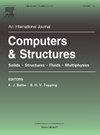无单元伽辽金法无量纲长度尺度对经典和应变驱动非局部弹性静力问题的影响
IF 4.4
2区 工程技术
Q1 COMPUTER SCIENCE, INTERDISCIPLINARY APPLICATIONS
引用次数: 0
摘要
无网格方法,如无单元伽辽金(EFG)方法,通过各种可调参数提供近似场变量及其导数的灵活性。无量纲长度尺度(dmax)就是其中一个控制局部支持域大小的参数。在无网格近似中,局部支持域的扩展是一种非局域性度量。这种通过改变dmax值来调整非局域性的固有灵活性可用于EFG方法模拟非局域弹性问题。本文基于Eringen的应变驱动非局部模型,建立了一维非局部欧拉-伯努利梁的EFG方法。对经典和应变驱动非局部欧拉-伯努利梁在标准边界条件下的弹性静力问题进行了数值分析,以评估EFG方法中dmax的影响。结果对经典和非局部弹性梁问题中精确逼近场变量和导数的dmax值的选取具有明确的指导意义。对于经典梁,通常接受的dmax范围在2到4之间,不能充分保证支撑处的力和力矩平衡。在非局部分析中也观察到类似的趋势,由于非局部本构建模引入的复杂性,甚至需要更大的局部支持。在执行边界条件的挑战是由一种改进的方法,结合缩放变换和拉格朗日乘子处理。该方法有效地结合了满足平衡要求的非局部梁的本构边界条件。本文章由计算机程序翻译,如有差异,请以英文原文为准。
Effect of non-dimensional length scale in element free Galerkin method for classical and strain driven nonlocal elasto-static problems
Meshfree methods, such as the Element-Free Galerkin (EFG) Method, offer flexibility in approximating field variables and their derivatives through various tunable parameters. Non-dimensional length scale () is one such parameter which govern the size of local support domain. The extend of local support domain is a measure of nonlocality in the meshfree approximations. This inherent flexibility to adjust nonlocality by changing the value of can be used for simulation of nonlocal elasticity problems using EFG method. This study formulates EFG method for one-dimensional nonlocal Euler–Bernoulli beams based on Eringen’s strain-driven nonlocal model. Numerical analyses are conducted on elasto-static problems in classical and strain-driven nonlocal Euler–Bernoulli beams with standard boundary conditions to evaluate the influence of the in EFG method. The results provides a clear guidance for choosing value of for accurate approximation of field variable and derivatives in classical and nonlocal elastic beam problems. For classical beams, the commonly accepted range of between two and four fails to adequately ensure force and moment equilibrium at supports. Similar trends are observed in nonlocal analysis, where even larger local supports are necessary due to the complexity introduced by the nonlocal constitutive modeling. The challenge in enforcing boundary conditions is handled by a modified approach, combining scaled transformations and Lagrange multipliers. Constitutive boundary conditions of nonlocal beams required for the satisfaction of equilibrium requirements is effectively incorporated using this method.
求助全文
通过发布文献求助,成功后即可免费获取论文全文。
去求助
来源期刊

Computers & Structures
工程技术-工程:土木
CiteScore
8.80
自引率
6.40%
发文量
122
审稿时长
33 days
期刊介绍:
Computers & Structures publishes advances in the development and use of computational methods for the solution of problems in engineering and the sciences. The range of appropriate contributions is wide, and includes papers on establishing appropriate mathematical models and their numerical solution in all areas of mechanics. The journal also includes articles that present a substantial review of a field in the topics of the journal.
 求助内容:
求助内容: 应助结果提醒方式:
应助结果提醒方式:


